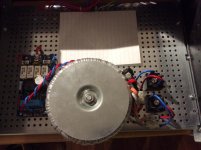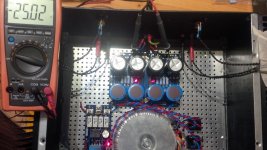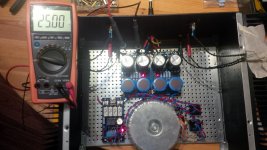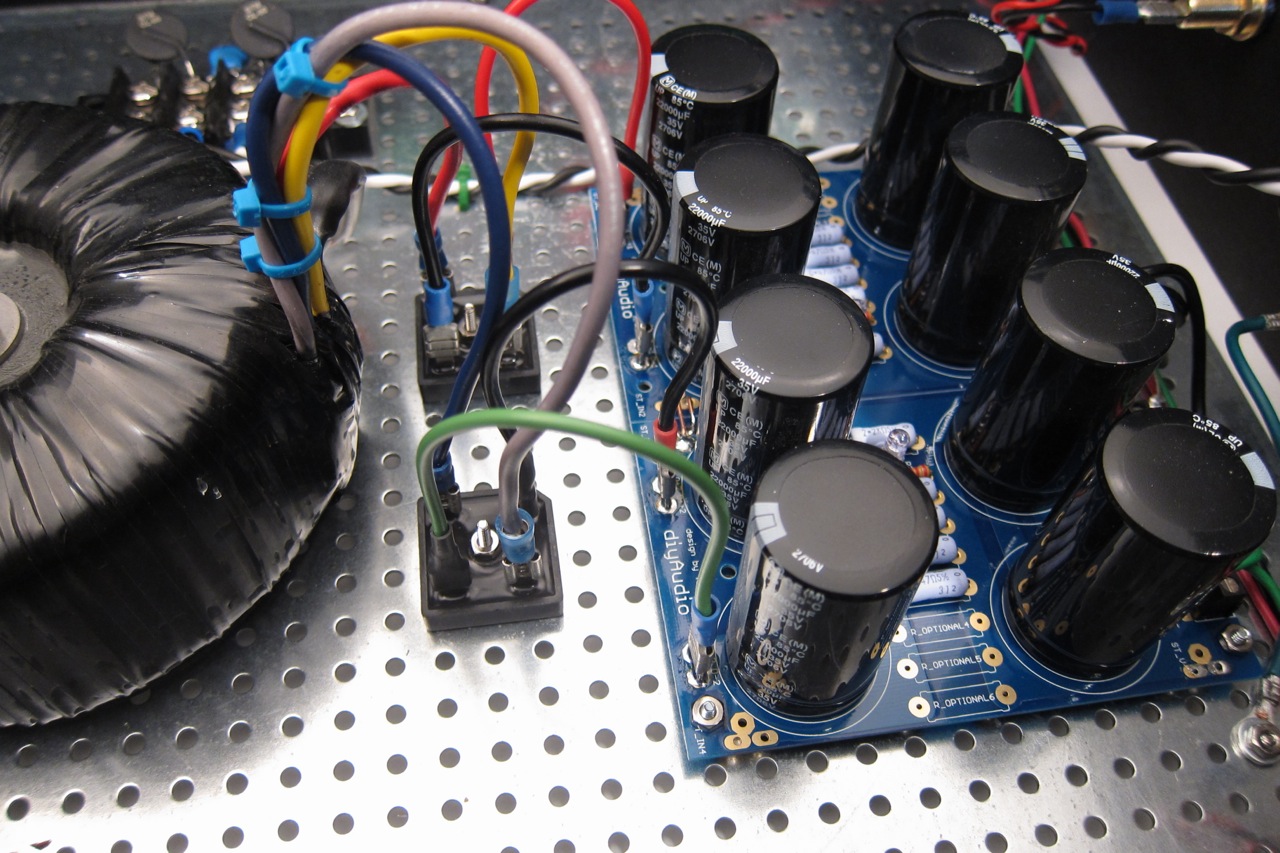When you say solders not allowed, does that include,
for instance,
where you have those 2 cl60s next to each other, i would twist the leads together to stop them falling apart before inserting into the connector block, can i not use solder to hold them together and make sure they don't get separated/mangled by the connector block screw?
I thought a lot of guitar amps use point to point wiring, including high tension supplies. Im sure my Groove tubes power amp has high tension wires soldered to the caps on the power supply.
I often tin my mains cables as well to stop them fraying either before they go into a screw terminal or a crimp. I seem to be able to get a more solid fix on it.
I would have thought if these parts were getting hot enough to soften the solder they would be melting insulation and all sorts.
Can you recommend a book with all these sorts of rules in?
for instance,
where you have those 2 cl60s next to each other, i would twist the leads together to stop them falling apart before inserting into the connector block, can i not use solder to hold them together and make sure they don't get separated/mangled by the connector block screw?
I thought a lot of guitar amps use point to point wiring, including high tension supplies. Im sure my Groove tubes power amp has high tension wires soldered to the caps on the power supply.
I often tin my mains cables as well to stop them fraying either before they go into a screw terminal or a crimp. I seem to be able to get a more solid fix on it.
I would have thought if these parts were getting hot enough to soften the solder they would be melting insulation and all sorts.
Can you recommend a book with all these sorts of rules in?
When you say solders not allowed,
That is very clear..................
You need to connect the PE wire direct and permanently to chassis. Soldering is not allowed: A permanent mechanical fixing...................
Do not solder the PE wire. Use a mechanical permanent fixing.
all these other examples are not the PE.does that include,
for instance,
where you have those 2 cl60s next to each other, i would twist the leads together to stop them falling apart before inserting into the connector block, can i not use solder to hold them together and make sure they don't get separated/mangled by the connector block screw?
I thought a lot of guitar amps use point to point wiring, including high tension supplies. Im sure my Groove tubes power amp has high tension wires soldered to the caps on the power supply.
I often tin my mains cables as well to stop them fraying either before they go into a screw terminal or a crimp. I seem to be able to get a more solid fix on it.
I would have thought if these parts were getting hot enough to soften the solder they would be melting insulation and all sorts.
Can you recommend a book with all these sorts of rules in?
You can do what you like as long as it's safe relative to the voltage you're working with.
Last edited:
Hello all
Just collecting parts for the PS, my question is - I have 4 Panasonic HA 22000 35v caps (5000ma ripple current) and 4 Vishay lytic series 256 22000 35v caps (4690ma ripple current). Can I mix them? (2 of each on either side?) - for Aleph J.....
Cheers
Tony
Just collecting parts for the PS, my question is - I have 4 Panasonic HA 22000 35v caps (5000ma ripple current) and 4 Vishay lytic series 256 22000 35v caps (4690ma ripple current). Can I mix them? (2 of each on either side?) - for Aleph J.....
Cheers
Tony
When you say solders not allowed, does that include,
for instance,
where you have those 2 cl60s next to each other, i would twist the leads together to stop them falling apart before inserting into the connector block, can i not use solder to hold them together and make sure they don't get separated/mangled by the connector block screw?
I thought a lot of guitar amps use point to point wiring, including high tension supplies. Im sure my Groove tubes power amp has high tension wires soldered to the caps on the power supply.
I often tin my mains cables as well to stop them fraying either before they go into a screw terminal or a crimp. I seem to be able to get a more solid fix on it.
I would have thought if these parts were getting hot enough to soften the solder they would be melting insulation and all sorts.
Can you recommend a book with all these sorts of rules in?
Tinning before inserting into screw terminals or crimps is bad practice, because solder is malleable , and has no resilience. That means that any vibrations on the leads will cause the solder to be compressed under the terminal screw, or crimp barrel, and won't hold it's shape. This will cause the termination to loosen after time.
For crimps, soldering after crimping is acceptable, but not necessary in most applications, as a properly formed crimp termination, using correct crimps and tools is both electrically and mechanically sound.
A better method for protecting wires under screw terminals is to use bootlace ferrules, especially for fine wiring.
Just preparing for my Power supply boards to arrive, so I wired my transformer up and my bridge rectifiers and got a few readings I didn't expect? It's a 18v 18v 400va transformer , which shows about 19v on the secondaries but readings after the bridges are about 17.6dc..?? Is this normal? I thought the dc out was higher than the ac in?!
Thanks.....
Thanks.....
With 19VAC you should have about 25VDC out from rectifier bridge (it may various a bit depend to Vr of your rectifier diodes in that bridge). It is something wrong with your components or wiring.
Sent from my iPhone using Tapatalk
Sent from my iPhone using Tapatalk
you have done the first part of your checking. Getting the transformer to power on without the bulb lighting up is good.Just preparing for my Power supply boards to arrive, so I wired my transformer up and my bridge rectifiers and got a few readings I didn't expect? It's a 18v 18v 400va transformer , which shows about 19v on the secondaries but readings after the bridges are about 17.6dc..?? Is this normal? I thought the dc out was higher than the ac in?!
Thanks.....
Now add on the smoothing capacotor/s and see if the bulb still does not light up.
Cheers Andrew, board is due here any time now, so in the mean time I hooked a Chucky cap and big resistor and voila 19v ac. 24.5 dc... Much more like it - the bridge just needed a bit of company!....
thanks, looks very nice.
What type of rectifiers did you use?
and on the schematic they mentioned: CX1,2 CS1,2, RS1,2
I'm building this PSU for the F-5 Amp.
Anyone can help me? I'm at the point of ordering at digikey.
What type of rectifiers did you use?
and on the schematic they mentioned: CX1,2 CS1,2, RS1,2
I'm building this PSU for the F-5 Amp.
Anyone can help me? I'm at the point of ordering at digikey.
I am using mine with mur3020, two diodes parallel in the bridge.
I am thinking to get from a one psu for two channels towards a more dual-mono psu...but instead of doubling everything...would it be possible to double just the board ? So no second xformer ?
I am thinking to get from a one psu for two channels towards a more dual-mono psu...but instead of doubling everything...would it be possible to double just the board ? So no second xformer ?
arjanv -
Buy 2 of these.
GBPC3502T GeneSiC Semiconductor | Discrete Semiconductor Products | DigiKey
Simpler, easier to use, smaller, works better, and MUCH less money than 8 diodes, 8 heatsinks. I greatly prefer these bridge blocks to discrete.
Buy 2 of these.
GBPC3502T GeneSiC Semiconductor | Discrete Semiconductor Products | DigiKey
Simpler, easier to use, smaller, works better, and MUCH less money than 8 diodes, 8 heatsinks. I greatly prefer these bridge blocks to discrete.
arjanv -
Buy 2 of these.
GBPC3502T GeneSiC Semiconductor | Discrete Semiconductor Products | DigiKey
Simpler, easier to use, smaller, works better, and MUCH less money than 8 diodes, 8 heatsinks. I greatly prefer these bridge blocks to discrete.
okay. So i can leave out the "Discrete Diode Bridge"? and replace it with 2 rectifiers?
- Home
- Amplifiers
- Power Supplies
- diyAudio Power Supply Circuit Board v3 illustrated build guide



